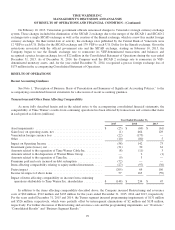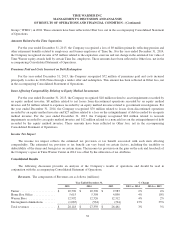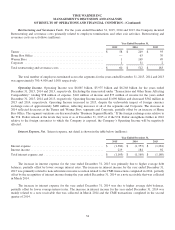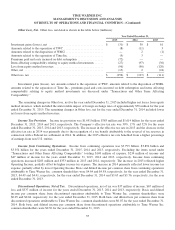Time Magazine 2015 Annual Report Download - page 39
Download and view the complete annual report
Please find page 39 of the 2015 Time Magazine annual report below. You can navigate through the pages in the report by either clicking on the pages listed below, or by using the keyword search tool below to find specific information within the annual report.TIME WARNER INC.
MANAGEMENT’S DISCUSSION AND ANALYSIS
OF RESULTS OF OPERATIONS AND FINANCIAL CONDITION - (Continued)
Home Box Office also derives subscription revenues from the distribution by international affiliates of country-specific
HBO and Cinemax premium pay, basic tier television and streaming services to their local subscribers and direct-to-
consumer streaming services. HBO GO is available to HBO premium pay television subscribers in a number of countries
outside the U.S.
Additional sources of revenues for Home Box Office are (i) the home entertainment sales of its original programming,
including Game of Thrones,True Blood,Boardwalk Empire and True Detective, via physical and digital formats and (ii) the
licensing of its original programming to SVOD services and international television networks.
Warner Bros. Time Warner’s Warner Bros. segment consists of businesses managed by Warner Bros. Entertainment
Inc. (“Warner Bros.”) that principally produce and distribute television shows, feature films and videogames. During the year
ended December 31, 2015, the Warner Bros. segment recorded Revenues of $12.992 billion (43% of the Company’s total
Revenues) and Operating Income of $1.416 billion.
Warner Bros. is a leader in television production and distribution. For the 2015/2016 season, Warner Bros. has
produced over 65 original series in the U.S., including (i) at least two series for each of the five broadcast networks
(including 2 Broke Girls,Arrow,The Bachelor,The Big Bang Theory,Blindspot,DC’s Legends of Tomorrow,The Flash,
Gotham,Lucifer,The Middle,Mike & Molly,Mom,Rush Hour,Supergirl,Supernatural,Vampire Diaries and The Voice),
(ii) series for basic cable networks (including Major Crimes,Pretty Little Liars and Rizzoli & Isles), (iii) series for premium
pay television services (including The Leftovers,Shameless and Westworld), (iv) series for SVOD services (including
11.22.63,Fuller House and Longmire), (v) series for first-run syndication (including The Ellen DeGeneres Show,Extra,The
Real and TMZ) and (vi) animated series for Cartoon Network, Adult Swim and Disney XD (including Airline Earth,Be Cool,
Scooby Doo!,Bunnicula,Mike Tyson Mysteries,Teen Titans Go! and Wabbit). Warner Bros. also licenses the rights to many
of its U.S. original television series in international territories. Outside the U.S., Warner Bros. has a global network of
production companies in 16 countries (located across Europe and South America and in Australia and New Zealand), which
allows Warner Bros. to develop programming specifically tailored for the audiences in these territories. These local
production companies also focus on developing non-scripted programs and formats that can be adapted and sold
internationally and in the U.S. Television product revenues are generated principally from the licensing of programs to
broadcast and cable television networks and premium pay television and SVOD services.
Warner Bros. is also a leader in the feature film industry and produces feature films under its Warner Bros. and New
Line Cinema banners. The Warner Bros. segment’s theatrical product revenues are generated principally through rental fees
from theatrical exhibition of feature films, including the following recently released films: Black Mass,Creed,Get Hard,The
Intern,Mad Max: Fury Road,Magic Mike XXL, The Man from U.N.C.L.E., San Andreas and Vacation, and subsequently
through licensing fees received from the distribution of films on premium pay television, broadcast and cable television
networks and SVOD services.
Warner Bros. is a leader in the home entertainment and videogame industries. The segment also generates television
and theatrical product revenues from the distribution of television and theatrical product in various physical and digital
formats (e.g., electronic sell-through (“EST”) and video-on-demand). In addition, the segment generates revenues through
the development and distribution of videogames, including the following recently released videogames: Batman: Arkham
Knight,LEGO Dimensions and Mortal Kombat X. Warner Bros.’ television, film and videogame businesses benefit from a
shared infrastructure, including shared production, distribution, marketing and administrative functions and resources.
The distribution and sale of home entertainment product in physical formats is one of the largest contributors to the
segment’s revenues and profits. For the past several years, sales of home entertainment product in physical formats have
declined as the home entertainment industry has been undergoing significant changes as it transitions from the physical
distribution of film and television content via physical discs to the electronic delivery of such content. Several factors have
contributed to this decline, including consumers shifting to SVOD and other OTT services and discount rental kiosks, which
generate significantly less revenue per transaction for the Company than sales of home entertainment product in physical
25
























